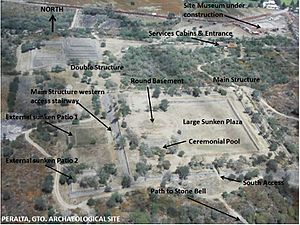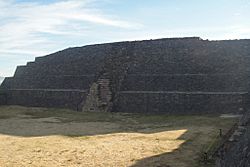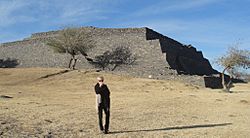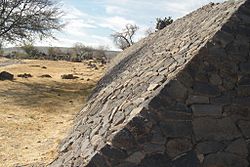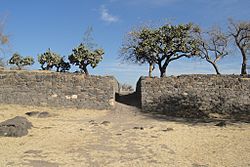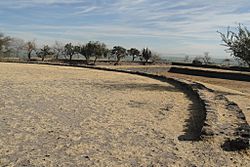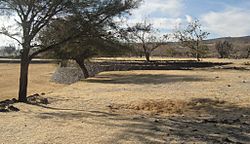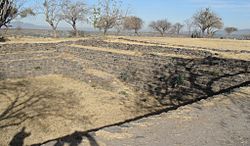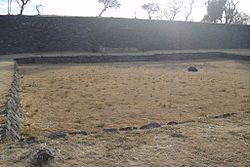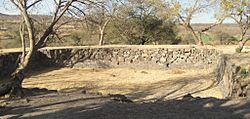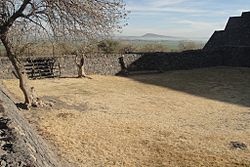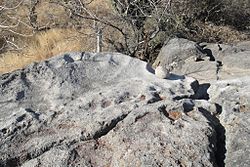Peralta (Mesoamerican site) facts for kids
Quick facts for kids Chichimec-Toltec Culture – Archaeological Site |
||
| Name: | Peralta Archaeological Site | |
| Type | Mesoamerican archaeology | |
| Location | San José Peralta, Abasolo, Guanajuato |
|
| Region | Mesoamerica | |
| Coordinates | 20°28′17″N 101°24′59″W / 20.47139°N 101.41639°W | |
| Culture | Chichimec – Toltec | |
| Language | ||
| Chronology | 100 to 900 CE | |
| Period | Mesoamerican Postclassical | |
| Apogee | 300 – 650 CE | |
| INAH Web Page | Non existent | |
Peralta is an ancient city in Mexico, found in the state of Guanajuato. It's an important archaeological site that shows us how people lived long ago in Mesoamerica. You can find it near the small village of San Jose de Peralta, in the Abasolo Municipality, Guanajuato.
This ancient city was quite large, covering about 130 hectares (that's like 240 football fields!). Archaeologists have found 22 pyramids here, along with many terraced fields used for farming. People first settled in this area around 100 AD. The city was at its busiest and most important between 300 and 650 AD. After this time, the people living there started to become nomads again, meaning they moved around instead of staying in one place.
Peralta is part of a group of ancient cultures known as the "Bajio Tradition." This culture developed between 300 and 700 CE, a time when the big city of Teotihuacan was losing its power and Tula was becoming important. Experts believe Peralta declined and was abandoned around 900 CE because people used up too many resources from the surrounding forests.
The site covers 150 hectares and has a main center with five smaller settlements around it. One of the most important buildings is a double temple with a special "Patio Hundido" (Sunken Patio). Another key area is called the Main Structure, sometimes known as La Mesita (The Small Table) or Recinto de los Gobernantes (Governors’ Precinct). It has a huge open space that was likely the city's main square. Archaeologists also found a semicircle area that might have been used for the Danza de Voladores, a traditional dance.
The architecture and pottery of Peralta and the Bajio Tradition are unique, different from other Mesoamerican societies. Peralta's large buildings show it was one of the biggest and most important ceremonial centers in the region.
Not much was known about these Bajio societies for a long time. People thought they were mostly hunter-gatherers, like the Chichimec groups. But now we know that places like Peralta were important trading spots, connecting central Mexico with northern and western Mesoamerica.
The people of Peralta likely lived in farming communities that worked together. They probably had social and religious connections, perhaps through family ties or local governments. These groups traded food, baskets, decorations, and fancy items like turquoise jewelry, shell necklaces, and obsidian tools.
About 1400 years ago, besides Peralta, there were five other major cities in the region: San Bartolome (Tzchté), San Miguel Viejo, Tepozán, Loza Los Padres, and Peñuelas. Circular buildings found at these sites show that these ancient cultures had ongoing connections with other civilizations across Mesoamerica.
Contents
Understanding the Bajio Region's Past
In ancient times, the Bajio region was a great place for people to live because of its fertile soil and plenty of water for farming. The earliest known group to live here were the Chupícuarios, who were active between 800 BCE and 300 CE. Their biggest city was called Chupícuaro, and their influence spread far and wide.
Chupícuario cities were connected to the Toltec city of Tula. When Tula fell, these farming cities in Guanajuato also started to decline. This, along with a long period of dry weather, caused these cities to be abandoned between the 10th and 11th centuries. Only the Guamares, an ethnic group, remained.
Later, different nomadic groups, often called Chichimeca, moved into the area. These groups included the Guachichiles, Pames, and Zacatecos. They were known for being warlike and semi-nomadic, meaning they moved from place to place. They didn't do much farming or build large cities. Some parts of the state were also home to the Otomi people, but they were mostly moved or controlled by the Purépecha in the southwest and the Chichimeca elsewhere.
By the 16th century, most of Mesoamerica was controlled by either the Aztec Empire or the Purépecha Empire. However, Guanajuato was not fully under either empire's control. It was on the northern edge of the Purépecha Empire, and the Aztecs had explored the area looking for minerals. But most of the state was ruled by various Chichimeca tribes, in an area the Spanish called the "Gran Chichimeca." These Chichimeca were mostly nomadic, with only a few small farming communities, mainly in the north.
The Bajio Tradition Explained
Not long ago, archaeologists didn't think the Bajio Region and much of Mexico's central plateau were very interesting. Little was known about the ancient societies that lived there. Historical records suggested that the people of the Bajio before the Spanish conquest were only Chichimeca, who were nomadic and warlike.
In 1972, Beatriz Braniff started to study the Bajio cultures. She suggested it was a "marginal" region, meaning it was on the edge of the more developed Mesoamerican areas. People thought that big cities like Teotihuacan had the most influence on the region's development. This made it seem like local societies didn't play a big role.
However, in the last ten years, archaeological studies in Guanajuato have grown a lot. Many old ideas about the Bajio's past have changed. We now have better explanations for how people lived in this area long ago.
Three main things have become clear:
- The Bajio was an important part of Mesoamerica. It was a trade route and a link between three cultural areas: Central, North, and West Mexico.
- Instead of just thinking about how big cities influenced smaller ones, we now understand that there were two-way relationships. Local societies like Peralta had their own important roles, which we are still learning about.
- During the Mesoamerican Classical period (between 300 and 700 CE), the Bajio had a large farming population with its own social and political organization. This unique culture is now called the Bajio Tradition.
Who Were the Chichimeca?
Chichimeca was a general name used by the Nahua peoples of Mexico for many different semi-nomadic groups living in northern Mexico and the southwestern United States. It meant something similar to "barbarian" in Europe. The Spanish also used this name, often in a negative way, to describe the semi-nomadic hunter-gatherer groups of northern Mexico. Today, only one ethnic group is usually called Chichimecs, the Chichimeca Jonaz, though they prefer to be called "Jonáz" or "Úza."
The Chichimeca were actually many different groups with their own languages and cultures. When the Spanish tried to take control of northern Mexico in the 16th and 17th centuries, these "Chichimecan tribes" fought back. Several groups joined together against the Spanish in what became known as the "Chichimeca Wars."
Many of the groups called Chichimeca are barely known today. Few records describe them, and they seem to have blended into the mixed (mestizo) culture or other indigenous groups. For example, we know very little about the Guachichiles, Caxcanes, Zacatecos, Tecuexes, or Guamares. Others, like the Opata or "Eudeve", are well-described but no longer exist as distinct peoples.
However, some "Chichimec" groups still exist today, keeping their unique identities. These include the Otomies, Chichimeca Jonaz, Coras, Huicholes, Pames, Yaquis, Mayos, O'odham and the Tepehuánes.
The first modern study of the peoples living in "La Gran Chichimeca" was done by Carl Sofus Lumholtz in 1890. He traveled through northwestern Mexico, meeting indigenous peoples in a friendly way. His descriptions of their rich and diverse cultures changed the idea that all Chichimecs were the same "savages." Even so, in Mexican Spanish, the word "Chichimeca" can still sometimes mean "wild."
Historian Paul Kirchhoff described the Chichimecas as having a hunter-gatherer culture. They gathered plants like mesquite, agave, and tunas (cactus fruit). Some also ate acorns, roots, and seeds. In certain areas, Chichimecas grew maize (corn) and calabash (squash). They made white bread and wine from mesquite. Many Chichimec tribes used agave juice as a substitute for water when water was scarce.
Exploring the Peralta Site
Even though local farmers knew about the structures at Peralta for many years, the site has only been formally explored three times. The first time was in 1978 by archaeology students. In 1981, archaeologists did a "salvage" exploration, meaning they quickly studied what they could. The third time was in 2002, when many structures were officially identified.
The most important parts of the archaeological site are two stepped pyramid-like buildings with a shared, enclosed plaza. There's also a huge raised platform and more enclosed plazas. Interesting items found nearby, like turquoise, copper bells, seashells, and jadeite, show that Peralta was part of a large trade network. This network stretched from Guatemala to the Caribbean and even to New Mexico. The people who lived here are part of the unique culture called El Bajío. Researchers are still trying to figure out their exact ethnic group.
The area that has been explored is only a small part of the entire ancient city. It probably extended all the way to Mount Peralta, several kilometers to the west, and all around the archaeological site.
What Happened to Peralta?
The people living in Peralta around 900 CE might have been from the Nahuatl and Otomi cultures, but we don't have clear records to confirm this. It's just an idea based on similarities with other ancient sites.
From the remains found, archaeologists believe that a natural disaster happened around 900 CE. This event greatly reduced the population and forced the survivors to leave the city.
Amazing Ancient Buildings
Many structures have been identified at Peralta, including a ballgame court, but most of them are still waiting to be explored and uncovered.
Within the site, archaeologists have found the remains of as many as 22 buildings, along with large farming terraces. Because of this, it's believed that more than 15,000 people lived here.
The impressive buildings at Peralta show that the people of the Bajio Tradition had highly skilled architects and craftspeople. Unlike typical Mesoamerican open patios or squares, Peralta is special because it has sunken patios surrounded by rooms and bordered by one or more temples. These temples were aligned with the equinoxes, which are specific times of the year when day and night are equal. Another unique feature of Peralta is its circular structures. These were typically used for special ceremonies, possibly dedicated to gods of wind, rain, and fertility. It's thought that Peralta had cultural connections with other regions, such as Guachimontones (in Teuchitlán, Jalisco) and Chalchihuites, Zacatecas.
The Main Structure: A Unique Design
The main structure at Peralta is truly unique in Mesoamerica. It's thought to be the first stage of construction, combining a large rectangular stepped building with "sunken patios" (like pools) and round structures built on top. The base of the building is stepped to fit the uneven ground it was built on.
This rectangular building faces east-west. Its outer walls are built at about a 45-degree angle. It was made from stone and earth, covered with stucco, and finished with clay mixed with plant fibers. The building's edge measures about 147 meters (482 feet) from east to west and 137 meters (450 feet) from north to south.
On top of the structure, there are three different levels. The lowest level has a huge sunken plaza. The middle level was probably an area for people watching ceremonies. On the western side of the top level, there's a deep "Ceremonial pool" with ramps and steps leading to lower levels. There are also remains of a circular base, about 42 meters (138 feet) across.
It's believed that rooms were built on the eastern side of the top level, possibly for leaders and high priests. Several human burials with offerings were found in different parts of the structure, but their origins are unknown. The offerings found show that Peralta traded with faraway regions. A turquoise necklace suggests possible trade with New Mexico and Arizona. Shell beads came from the Pacific Ocean coast. Other offerings included two well-preserved wooden pieces, colorful pigments, various ceramic pots, and items carved from obsidian and flint stone.
The main entrance stairway to this structure is on its western side, facing a platform and two "sunken patios." There's also a second entrance on the southern side.
Sunken Patios: Places for Ceremonies
On the ground level, to the west of the Main Structure, there's a large platform with two big "sunken patios." These were probably used for ceremonies before the main events.
Sunken Patio 1 is west of the Main Structure and lines up with its main stairway. It's larger but not as deep as the other sunken patio.
Sunken Patio 2 is located south of Sunken Patio 1.
The Double Temple: Two Temples, One Platform
The double temple is another unique structure at Peralta. It includes two buildings and a plaza, all built on a single platform.
It's thought that these temples were built in layers, which was common in Mesoamerica. Every few years, a new structure would be added over older ones, perhaps by new leaders or for new reasons.
These layers were built using obsidian stones, turquoise, tepetate (a type of soil), and a mix of clay and plant fibers.
Archaeologists believe that there were other buildings on top of these structures, used for religious or political purposes by the builders.
In front of both temples is a sunken plaza. It has a complex system of stairways for people to enter from outside and move from the plaza to the temples. The plaza also had a drainage system to prevent it from flooding.
The Mysterious Stone Bell
The villagers of San José believed that Peralta was a magical place, enchanted by the spirits of its first inhabitants. At the very south end of the archaeological site, there's a special boulder rich in minerals. Local elders used this stone as a bell to call people together for spiritual gatherings at the site.
This large basalt stone makes a unique sound when struck with another stone (like the smaller round stone shown in the picture). It's part of a larger group of stones, hanging over the side of a hill, and it already has cracks in at least three places.
See also
 In Spanish: Zona Arqueológica de Peralta para niños
In Spanish: Zona Arqueológica de Peralta para niños


